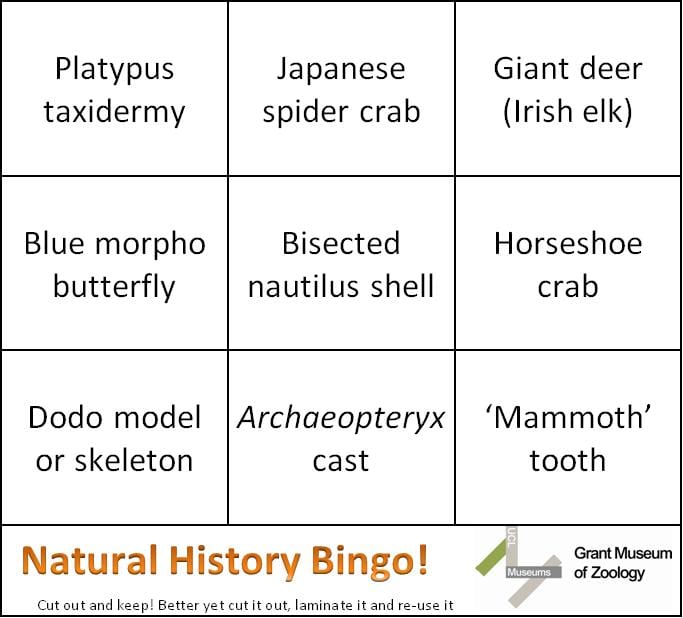NATURAL HISTORY MUSEUM BINGO!
By Mark Carnall, on 15 October 2013
My colleague Jack Ashby alluded to the Natural History Bingo Card in a recent blog post so I thought I’d take the time to present it to the wide world! Natural history museums are funny places. Despite the millions of species of animals and the enormous variation within species between broods, sexes, life stage, populations and seasonal variations you’d expect that you could visit every natural history museum in the World (finances allowing) and never see the same thing twice. You might think that, but the truth is many natural history museums have the same stuff on display whether you’re at the Grant Museum, the Natural History Museum London or in Paris, New York, Prague or Plymouth.
In fact, some specimens are so common, you can go around a natural history museum with this handy NATURAL HISTORY MUSEUM BINGO* and nine times out of ten you’ll have seen most of these specimens before you get to the gift shop. So what gives?

Click to embiggernate & cut out and Keep! Natural History Bingo modified from the version in Carnall, M.A (2011): Completely Rethinking the Organisation of Natural History Museums: A Taxonomically Arranged National Collection. NatSCA News:21
I originally published the above figure in a paper looking at why natural history museums are all the same and what, if anything, could be for natural history museums to make the best use of their vast collections. You can tell from this Microsoft Paint produced chart that tongue was firmly in cheek but why does the Bingo hold true (go ahead and try it next time you are museuming)? It’s partly because, unlike other kinds of museums, natural history museums by and large have the same remit and are collecting and presenting the same thing (the natural world). But with so many different species and shapes of organisms why are the same specimens used as the public face of biology (specifically zoology) here?
This is not to say that ‘duplicates’ in natural history museums aren’t important. For many kinds of scientific analysis a diversity of specimens is ideally needed in order to understand how a species varies (think for a moment about the diversity of people). Although, any one edible sea urchin, Echinus esculentus, may resemble the next, each specimen is unique genetically and environmentally (the events and conditions that affected the birth, life and death of the individual animal). However, we’re looking specifically at the public displays in this context not the collections of hundreds, thousands and even millions of specimens of the same specimens that typically make up stored collections.
You can probably already sense why some of these are usual suspects in natural history galleries. Some of the specimens on the card represent big ideas that changed zoology and society, some are pretty objects that stop visitors in their tracks, others are simply awe-inspiring specimens and some have come to be symbolic of natural history museums, zoology and science. There are also other factors at play, some of the specimens are too big, cumbersome or fragile to be permanently stored so have to go out on display, some of these specimens are ‘expected’ to be seen in a natural history museum and others are sexy symbols of incomprehensibly vast and otherwise mundane animals.
I’ll be looking at each bingo specimen in turn over the coming weeks to examine why you’re likely to see the ‘usual suspects’ in natural history museums across the world! In the meantime, why not print out a bunch of bingo cards and see how many museums you can full house! Drop the scores by museum in the comments. I’m sure you can think of other usual suspects (including the aforementioned Agadoo do do, Megatherium lick a tree).
* I’m well aware it isn’t bingo in the strictest of senses
Eyes down, Mark Carnall is the Curator of the Grant Museum of Zoology
5 Responses to “NATURAL HISTORY MUSEUM BINGO!”
- 1
-
2
Is Archaeopteryx a bird or not? | UCL UCL Museums & Collections Blog wrote on 23 January 2014:

[…] a natural history museum you’ve undoubtedly walked past a cast or two, it is after all one of our Bingo! animals. It was the first fossil that really enshrined the ideas about evolutionary change. Ever since […]
-
3
The Grant Museum’s Third Birthday | UCL UCL Museums & Collections Blog wrote on 14 March 2014:

[…] Why are all natural history museums the same? NATURAL HISTORY BINGO […]
-
4
Pom pom mammoths | FromShanklin wrote on 2 September 2014:

[…] be different from museum to museum, but some of the specimens may be the same, as highlighted by ‘Natural History Museum Bingo’ developed tongue in cheek by my friends at UCL’s Grant Museum. And so what if some are the […]
-
5
The beauty of the beast | FromShanklin wrote on 20 March 2015:

[…] at UCL’s Grant Museum of Zoology, Mark Carnall, included it in his slightly tongue-in-cheek, ‘Museum Bingo’. Here you take the Museum Bingo card into a museum and cross off the specimens you see. More […]
 Close
Close


[…] in October, I introduced this series (here’s a link to the opening post) about the specimens you’re near guaranteed to see in every natural history museum. […]